Preface to all 21 parts: This is a special holiday weekend, because not only does it contain Good Friday and Easter, but it also begins the Slope of Hope's 20th year in continuous operation! Through the weekend, I will be sharing some of my favorite posts from the past, plucked from among the literally 30,000 posts I've created over the years. Here is one of them:
In the early 1980s, I unwittingly stumbled onto one of the biggest high-tech battles in business history. One which involved the largest legal payout ever awarded in a California lawsuit and sent a member of the Forbes 400 fleeing to a tiny island in the Marianas to hide from the tax man. And all I was trying to do was find a publisher for my computer games.
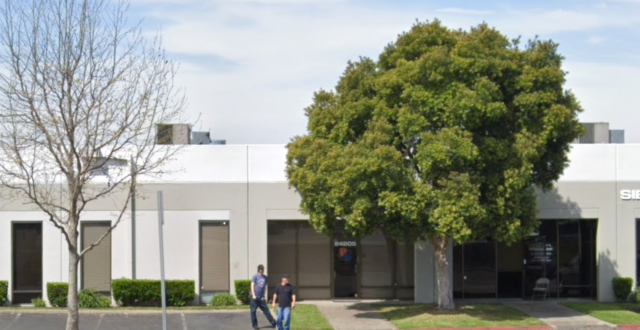
Back in 1982, a fast-talking, loud-mouthed hustler named John Martin-Musumeci created a company that he believed would be sort of an agent to software developers, in the same way that Creative Artists is the agent to singers and actors. It was called The Software Guild, and I got to be one of its early members.
John had a penchant for creating lots of closely-related companies, so he also created a firm called Softsmith, which was to be the publisher of the products that his programmers would create, and another firm called Information Please which would be the retail presence for these same products.
I was just a kid when I met John, and I had never met anyone quite like him. He seemed to me like an archetypal Brooklyn salesman (even though I had no idea where he was from), and I figured he was in his 50s, even though he was twenty years younger than that. I remember overhearing him loudly telling someone on the phone he’d send a helicopter for them. Considering how dowdy their office was (see photo above), John seemed to talk a lot bigger and louder than his little company would warrant.
As the company started to acquire software titles, I had my doubts if they were going to succeed. They seemed to have way too much software, none of it particularly good, and the kind of outlets they were securing to sell their wares yielded articles like this:
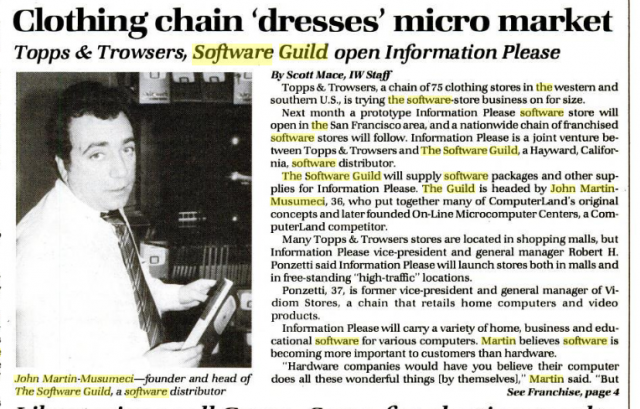
So, yeah, you read that right: some poor soul walking into the (long since bankrupt) clothing store Topps & Trowsers would be confronted with an Information Please kiosk selling software for the Apple II and TRS-80. I suspect they managed to sell literally hundreds and hundreds of dollars of product from a chain like that.
In my interactions with John and The Software Guild, I heard occasional rumblings about some kind of big legal drama, but I had no idea what it was. Now, through the long lens of history, we can grasp it, but to do so requires a bit more back story.
Rags to Riches
William Millard grew up in a working class household in the San Francisco Bay Area. As a young man, he took on just about any job that he could: he drove trucks, did some welding, and even dug ditches. He enrolled in a local college, but even in those days of very cheap tuition, his family could only afford a few semesters before he had to drop out.
In 1958, in his mid-20s, Millard started working at a firm called Pacific Finance, and he got his first experience with early computers and data processing. He spent the 1960s working a variety of data processing jobs, culminating in his own company, Systems Dynamics, Inc., in 1969.
Being the 60s, particularly in the Bay Area, there were plenty of hippie-dippy freaks, but one particular weirdo who became a fairly major social force was a used car salesman named Jack Rosenberg who re-branded himself as Werner Erhard. Yes, that Erhard, as in “Erhard Sensitivity Training”, or EST. Anyone from the Bay Area or with a decent knowledge of 1970s pop culture knows what I’m talking about.
In fact, I wrote about the EST venue known as the Esalen Institute in the tantalizingly-titled post Thanks For Not Molesting Me about a year ago. Suffice it to say that people into EST, in my opinion, where the proverbial wolves in sheep’s clothing. On the outside, all loving and caring and new-age hippie, yet on the inside ready to rip your guts out. William Millard became an EST fanatic almost to the point of religiosity.

There were a couple of early Millard employees who would have a profound effect in his future over a decade later. One of them was a Boston elite by the name of Phillip Reed III (yes, III) who hailed from a well-to-do East Coast family that, among other things, owned a venture capital firm named Marriner & Company. Whereas Reed had grown up in luxury and benefited form a Harvard education, his boss, Bill Millard, only had a few semesters of a no-name college under his belt.
The other fellow was somewhat closer to Millard’s background and style, John Martin-Musumeci, who had put together a small chain of employment agencies and sought to help Millard expand his business. An important new development in Millard’s enterprise was the creation of a primitive microcomputer with the dry name of IMSAI 8080 (pop culture note: those of who you saw the 1982 movie War Games actually saw the IMSAI on Matthew Broderick’s desk, since it looked all nerdy and computery, what with its switches and lights).

Millard’s little businesses were never well-capitalized, and IMS was no exception. He sought help from Reed’s father, P. Loring Reed, Jr., who agreed to loan the firm $250,000 in January 1976. The interest rate was 12%, and shrewd businessman that Loring Reed was, he made the note convertible to a 20% equity stake in IMS. (Obviously in those days, business capital was vastly harder to come by compared to now, when insane money-losing enterprise that WeWork have no problem garnering billions of dollars from “investors” for their money-bleeding enterprise. But I digress.)
Desperate for the cash, Millard was in no position to quibble over the terms, so he happily signed the deal and found his checking account fat with a fresh quarter-million dollars in capital. As competition began to creep in from tiny new computer startups, including a two-man outfit on the peninsula called Apple Computer, Millard began to listen to the ideas of John Martin-Musumeci, who believed that the way to make money in this new microcomputer industry was retail, not manufacturing.
Thus, Millard started to draw cash out of IMS and put it into yet another new venture, Computer Shack. Marriner got wind of this co-mingling of assets and made it clear to Millard that the $250,000 loan was for IMS, not other business ideas, and he’d better restore the funds to their original purpose.
Millard refused, and after months of bickering, they finally reached a compromise: Millard would be permitted to use the funds in the Computer Shack venture, but the convertible nature of the note would apply not just to IMS, but also to any and all businesses that Millard created. In short, whatever Bill Millard created, Marriner could claim a 20% stake. That way, Marriner wouldn’t have to worry so much about where their capital was being deployed.
By this time, Reed’s son, Philip, had enough of Millard and IMS, so he left the firm. But Philip wasn’t the only employee with whom Millard quarreled. Martin-Musumeci was also becoming impatient with Millard and his refusal to share a piece of the new enterprise. The employee wanted 5% of the firm in exchange for his efforts, but Millard dug his heels in. Eventually, Millard turned over 1% of the firm, but by then the relationship was so strained by the two parted ways. Thus, in early 1977, both Reed and Martin-Musumeci had angrily left IMS, and Millard was content to manage his companies on his own.
ComputerLand
Millard, his wife, and his young daughter would sit in their kitchen of their modest home and hand-assemble the parts for the IMSAI computer system, which they sold to hobbyists for a few hundred dollars. Muffin trays served as vats for the dozens of little parts. While the “startup in a garage” story with IMSAI was little different than that of Apple, the fates of the two early computers were obviously quite different.
Simply stated, the IMSAI wasn’t selling well, and it was clear to Millard that the prospect of selling personal computers in franchised retail stores was more to his liking than being a homebrew computer manufacturer. IMSAI itself was buried in $1.9 million of debt, a chunk of which Millard was personally liable to cover, so the financial pressure was tremendous.
The handful of Computer Shack stores was doing well, however. The only road bump so far had been some legal sabre-rattling from Tandy Corporation, which owned the similarly-named Radio Shack chain, so Millard agreed to eliminate any reference to “Shack” in the name and re-dubbed his nascent chain ComputerLand.
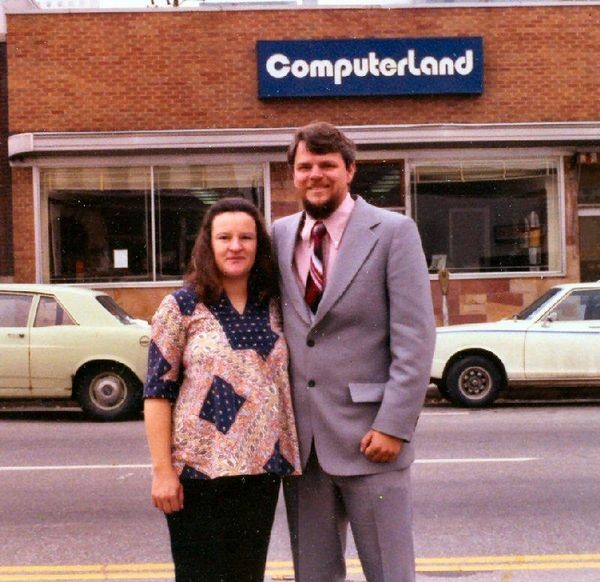
Millard’s timing could not have been better. The Apple II and Commodore computer lines were selling briskly, and the market for software and peripheral products was strong as well. The early adopters of microcomputers were willing to pay full retail, and typical margins were in the 40% range. Millard’s ComputerLand expanded from 24 stores in 1977 to 147 stores by 1980, with revenues growing from $1.5 million to $75 million during the same timespan.
The real bonanza came with the launch of the IBM PC, however. The launch of the IBM 5150 (its actual name, although mercifully IBM focused on the nickname “PC” instead) completely changed the personal and professional fortunes of everyone it touched including, notably, putting Bill Gates on the path to be the world’s richest man instead of the owner of a small computer software company.
Thus, when IBM selected the parties that would be permitted to sell its new product, it gave exclusive rights to only three entities: its own IBM retail stores, Sears, and…………..ComputerLand. It was the most important blessing the business would ever receive, since it was virtually a license to print money.
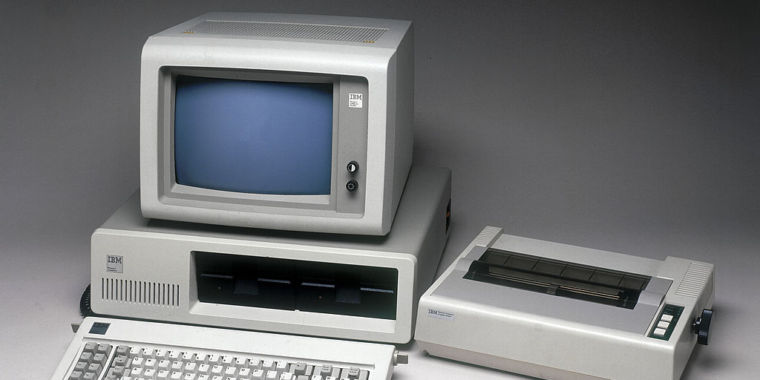
After the launch of the PC, sales at ComputerLand exploded ten-fold, peaking at $1.4 billion in 1984. The next year, they had more than 800 stores in two dozen countries. Franchisees coughed up $75,000 just to open their doors and then committed nearly 10% of their gross revenue back to the parent company. As Millard arrogantly declared in an interview with Forbes, “I am the biggest winner of all in the microcomputer industry.” With a net worth approaching two-thirds of a billion dollars, Millard held a coveted spot on the Forbes 400 list of richest Americans.

Micro/Vest
Although John Martin-Musumeci had pledged to Millard that he would “kick his ass” with his own chain of competing computer retailers, that never transpired. Instead, John had an idea that was much cheaper and yet opened up the prospect of making him a rich man.
Almost no one knew about the $250,000 business loan Marriner had made to IMS back in 1976. It was ancient history as far as the billion dollar ComputerLand was concerned. Yet John knew about it. Far more important, John was probably only one of four people on the planet who knew it had the spiffy little feature of being convertible not just to 20% of IMS (as originally drafted) but, thanks to Millard’s signature, 20% of every single business William Millard had ever created.
Shrewdly, John had acquired the note from Marriner before ComputerLand’s success had become a foregone conclusion. He was not a rich man himself, so he put together a syndicate called Micro/Vest whose sole purpose was to acquire the note and then litigate for the 20% stake. In a way, what had started off as a business loan had become a warrant. Not just a warrant, but a warrant whose value was not the $250,000 purchase price but instead worth potentially hundreds of millions of dollars.
Piece by piece, John sold off stakes in Micro/Vest, and the value of the stakeholders soared. A 1% stake in the syndicate in 1981 cost $10,000, but in 1984, the same “point” was worth almost $400,000. Amazingly, as ComputerLand was growing, Micro/Vest made several efforts to sell the 20% stake back to Millard, but he refused every time. Yet its value kept rising, hand-in-hand with ComputerLand’s prosperity.
Spendthrift
Although Millard spoke piously about maximizing human potential and feeding all the starving people of the world, he had no misgivings about treating himself to every luxury money could afford him. He had two jet planes as well as a propeller commuter plane. He purchased a winery for himself and was accompanied by a trio of security guards. He issued generous dividends to the shareholders (of which he was 96%), and he granted himself a $1 million management fee on an annual basis. And since he would hold meetings from time to time in his palatial home, he had ComputerLand paid him a $32,000 fee each month for access to his house.
He also wasn’t above nepotism. By far the most capable and respected executive at ComputerLand was Ed Faber, but after he grew weary of Millard’s excesses and left, the person put into his position was none other than twenty-something daughter Barbara Millard, who had absolutely no formal business training. She did have an important prerequisite for Millard, though, which was unquestioned loyalty.
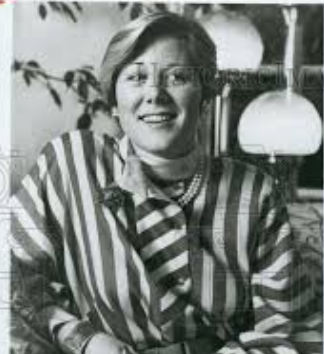
Still, ComputerLand’s tremendous success wasn’t going to make Micro/Vest vanish, and once it was clear Millard wasn’t going to hand over 20% of his firm without a fight, it was time for one of the biggest commercial lawsuits in U.S. history.
The Trial
The trial was held at the Alameda County courthouse, only miles away from where Millard had been born in 1932, fifty-three years earlier. Although the paper trial of the promissory note seemed plain enough, ComputerLand tried to argue that oral agreements had superseded the terms and that the Micro/Vest investors were nothing more than greedy opportunists.
Both teams had hired superb legal teams, and the trial went on for nearly two months. In the end, however, the jury didn’t care whether Micro/Vest was greedy or not; instead, the simple fact of the matter was that Millard had plainly signed away 20% of his business interests years ago, and the Micro/Vest group were the rightful owners of the convertible note. It was time for ComputerLand to finally pay the proverbial piper.
To the delight of Micro/Vest and its leader, John Martin-Musumeci, the jury not only awarded them the entire equity amount they wanted, they also tacked on a nine-figure cash settlement as punitive damages for making Micro/Vest have to go to trial in the first place for what was so clearly their property. Just to add sale to an already deep wound, the judge even added an $11 million judgment to reimburse Micro/Vest for all their attorney fees as well as $5 million in dividends that should have been paid. It was an absolutely disastrous outcome for Millard personally and ComputerLand as a company.
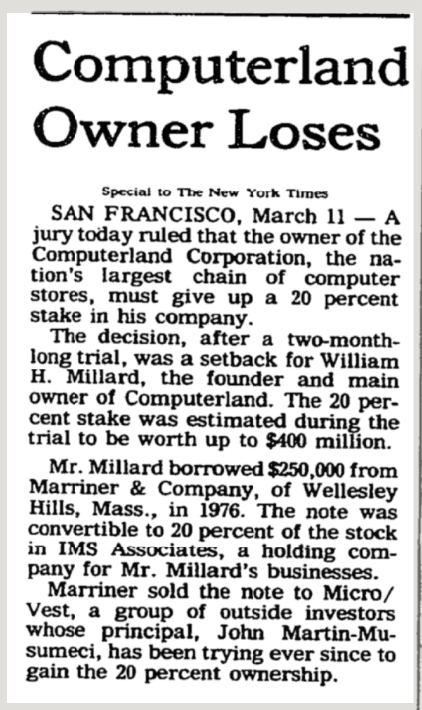
The company’s corporate bank immediately suspended ComputerLand’s generous line of credit, since the viability of the organization was suddenly in question. Franchisees, already unhappy with the huge fees they were paying in to a company whose star was clearly fading, were in open rebellion.
A few months after the verdict, Millard openly entertaining the idea of declaring bankruptcy, since even IBM was becoming reluctant to ship them products without prompt payment. Rarely had a business seen such a rapid reversal of fortune, and certainly never before had such misfortune been clearly at the direction of the company’s founder and CEO.
Coda
ComputerLand managed to survive, and in 1987, Millard managed to sell his 96% stake in the company for $80 million, about one-tenth of its peak value. Wanting to keep every dime, he immediately fled to the faraway island of Saipan, seeking a place he could get his cash fortune out of the reach of the United States government.
The new owners of the company intended to take it public, at long last, but not surprisingly, Wall Street had completely cooled to the prospect of a shrinking retailer whose fortunes had peaked years earlier rolling out an IPO. The company reshaped itself as a distributor under a different name, although a sprinkling of ComputerLand stores (such as one of the original stores in Berkeley) persist to this day.
Millard faded from the public’s memory, but the government tends to maintain an abiding interest in tax scofflaws, so they kept their eyes on the guy. There’s hardly any information about Millard (which is kind of shocking, considering the lofty position he once had in corporate America), although this ABC News Report from eight years ago indicates he was found in a different tax haven, the Cayman Islands, still keeping a safe distance from the hands of the United States Treasury.
As for John Martin-Musumeci, there is even less information, with the exception of this court case that I managed to find. Incredibly, even though John had assembled the most fiendishly crafty scheme that I’ve ever heard of to make an incredible amount of money, it looks like he went personally bankrupt with tremendous speed after his astonishing courtroom victory.

This extraordinary tale reminds me of a terrific movie I’d recommend, A Simple Plan. In it, a group of people seems to find a way to completely change their lives by becoming fabulously rich, only to find, in the end, their lives ruined by completely unexpected circumstances.
I’m sure plenty of people would love to be in Millard’s shoes, even to this day, but when considering the fact that a titan of business from the early 1980s is now a nearly-forgotten tax fugitive, and his nemesis was personally bankrupt on the heels of a nine-figure courtroom victory, we have to stand in awe of just how fate can twist our destinies in ways unimaginable.

